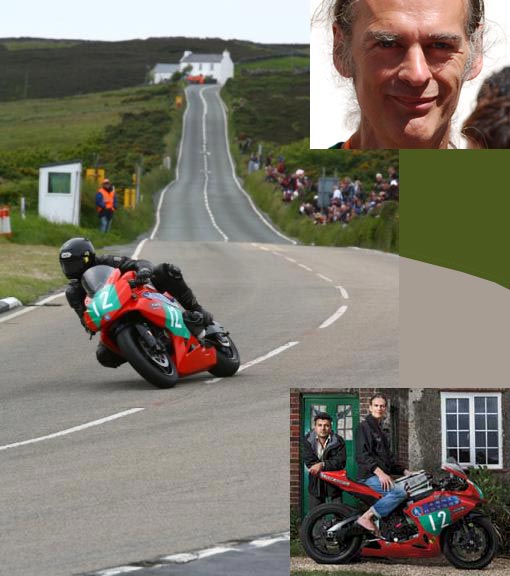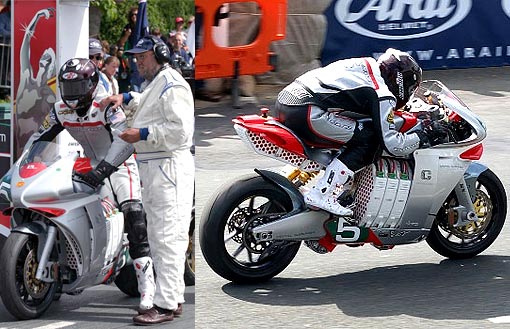You are hereBlogs / WcP.Scientific.Mind's blog / Millions of American R&D $$$ chase tail of zero-emissions race motorcycle engineered in India by no-money privateer
Millions of American R&D $$$ chase tail of zero-emissions race motorcycle engineered in India by no-money privateer

(quote)
"Tourist Trophy eXtreme Grand Prix". TTXGP is not a motorcycle race but the motorcycle race: the first, the most famous, and by far the deadliest. So it's all the more surprising that in the week before the race, a dark horse emerges, freaking out all the factory teams. The fastest bike in the TTXGP prelims - two qualifying runs around the island - turns out to be from Team Agni, a total unknown, a mere privateer. Millions of American research-and-development dollars find themselves chasing the tail of a no-money ratbike engineered in India. Cedric Lynch’s first electrical motor was made from flattened soup cans. His latest powered the Team AGNI machine to a historic TTXGP victory around the famous Isle of Man Mountain Course. Born in December 1955, Cedric Lynch developed a fascination with anything electrical or mechanical which turned into a life obsession.

The Isle of Man is a small British possession in the Irish Sea. Inland, a native breed of four-horned sheep graze in verdant fields. On the coasts, castles touch the sea. The Manx have their own (albeit dead) language, their own money, their own laws, and--tellingly for this story--no national speed limit. This quirk of governance makes the place a natural host to a bloody ritual that has taken place nearly every spring for a century: the Tourist Trophy. The TT is not a motorcycle race but the motorcycle race: the first, the most famous, and by far the deadliest.
It's also a party: 40,000 bikers invade the island determined to scare the wool off the sheep while screaming through the Snaefell Mountain Course, a winding circuit of public roads cordoned off for the event. The circuit climbs from sea level to 1,380 feet, snaking for almost 38 miles through 200-some turns on country roads that cut through village, hamlet, and farm. Much of the track is hemmed in by dry-stacked fieldstone walls topped by spectators drinking their pints. There is no safe place to crash. Racers die or are maimed every year.*

As in warfare, the carnage is accompanied by technological progress. Soichiro Honda came to the race in 1959 having declared five years earlier that it was time to challenge the West. Less than a decade later, his company won the world manufacturer's title in every class: 50cc, 125cc, 250cc, 350cc, and 500cc. Not long after that, the British motorcycle industry was itself conquered, wiped out by mismanagement and superior Japanese technology. Ironically, the technical advances that made racing bikes so fast led the Fédération Internationale de Motocyclisme (FIM), the sport's governing body, to decertify the race in 1976, calling it too dangerous. Thus, pros no longer ride the TT. However, the race's bloody reputation makes the TT, if anything, even more prestigious than FIM-sanctioned events. To compete in it, in the words of the legendary FIM rider Valentino Rossi, "you need to have two great balls."
This year, the Manx government added a futuristic new event to the June race schedule. The TTXGP, for "Tourist Trophy eXtreme Grand Prix," was billed as the first zero-emissions motorcycle race. While any technology could enter, as a practical matter zero emissions means electric. Even the FIM got on board, making the TTXGP the first FIM-approved TT race in over 30 years and the first officially sanctioned electric-motorcycle race ever. "It is either going to be the most important day in the next hundred years of motorcycling or a complete debacle," said Aaron Frank, an editor for Motorcyclist magazine who traveled from Milwaukee to watch the race. "But either way, it's worth watching."

22 electric bikes show up to compete. While many of the entries are experimental one-offs from technical universities or obsessive hobbyists, three entrants are so-called factory teams: Brammo, Mission Motors, and MotoCzysz. All of them hail from the West Coast of the United States. Brammo is in Ashland, OR, Mission Motors in San Francisco, and MotoCzysz in Portland. For the TTXGP, Brammo has upgraded almost every component in its bike to create two 100-mile-per-hour crotch rockets, both entered in the race. The Brammo racers are fast, light, and nimble but under-spec'd compared with what Mission and MotoCzysz trailer in: full-size race bikes heavy with batteries, capable of reaching 150 mph.
So it's all the more surprising that in the week before the race, a dark horse emerges, freaking out all the factory teams. The fastest bike in the TTXGP prelims--two qualifying runs around the island--turns out to be from Team Agni, a total unknown, a mere privateer. Millions of American research-and-development dollars find themselves chasing the tail of a no-money ratbike engineered in India.
The race is not won by top speed, of course--it's the fastest average speed that counts. And Agni is first over the finish line with a lap time of 25 minutes, 53.5 seconds. A cry goes through the grandstand crowd: "India wins!" Three minutes behind, for second place, is XXL. Brammo's good bike takes third, the only factory bike to make it to the podium. Mission comes in fourth, and MotoCzysz and the second Brammo bike are DNF: did not finish.
(unquote)
Photos courtesy of Jude Edginton, motorcyclenews.com, BBC News, Club MotoAmerica / MotorcycleUSA / Ian Kerr, and evracingnews.com
Original Source: Technology Review, Isle of Man Government and BBC News



















It seems that the event was exciting and fun for a good cause.